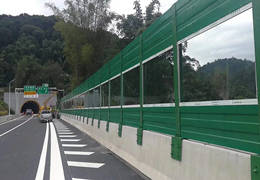The sound insulation facilities on the road, some people call it a sound barrier, and some people call it a sound absorbing barrier
Sound insulation is to isolate sound and prevent the transmission of sound. The use of materials or components to isolate or block the transmission of sound to obtain a quiet environment is called sound insulation. Sound insulation is to prevent the sound of the outside world from spreading in, in order to achieve the effect of maintaining the tranquility of the internal space, so the sound insulation barrier is generally based on the reflection of sound waves.
When the sound wave is incident on the surface of the sound insulation barrier, the transmitted sound energy passing through the barrier and entering the other side is very small, indicating that the sound insulation capacity of the barrier is strong. The difference in decibels between the incident sound energy and the transmitted sound energy on the other side is the sound insulation of the barrier. The goal of the noise barrier is to focus on the smaller the transmitted sound energy on the other side of the incident sound source, the better. For example, the noise of vehicles on both sides of the road needs to build a sound insulation system on the periphery of the house. Generally, a sound insulation wall is used to isolate the external noise. outside the door.
Sound absorption is the phenomenon of energy loss after sound waves hit the surface of the sound-absorbing barrier. The popular explanation of sound absorption is to leave a channel for sound waves to enter (a channel composed of countless tiny holes connected together, or countless fibers). Intertwined and mixed together to form countless tiny gaps) but once the sound wave goes in, it cannot come out. Because the channel is too long, the sound wave drills back and forth in it, and the left and right collisions gradually consume energy in the process, which plays a role in sound absorption. effect.
The sound-absorbing barrier has little reflection of incident sound energy, which means that sound energy can easily enter and pass through this material. The material of the sound-absorbing barrier should be porous, loose and breathable, which is a typical porous sound-absorbing material. Its structural sacrifice is: the material has a large number of micropores that are connected to each other, from the surface to the inside, that is, it has a certain degree of air permeability.
Usually, noise barriers and sound absorbing barriers can be used in combination. In sound barrier projects, sound absorbing screens are generally used at the bottom and top to absorb vehicle noise, and noise barriers are used in the middle to block the transmission of noise. Both sound-absorbing barriers and sound-absorbing barriers have their own strengths. Combining their advantages is a composite sound barrier. The composite sound barrier has both sound-absorbing and sound-insulating functions, so it is favored by people and has a wide range of applications.
Post time: Jun-22-2022





